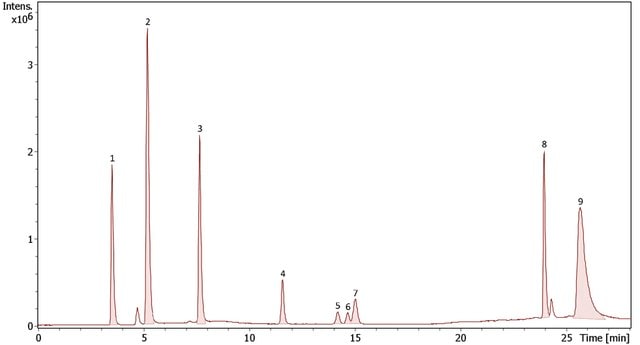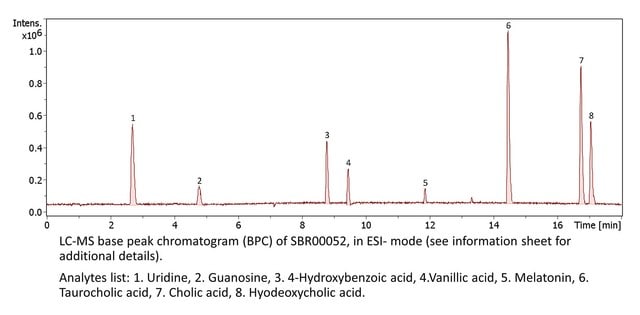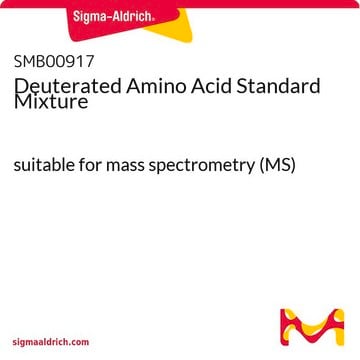SBR00055
Polar Metabolites QC Mix
suitable for LC-MS
Se connecterpour consulter vos tarifs contractuels et ceux de votre entreprise/organisme
About This Item
Code UNSPSC :
41116107
Nomenclature NACRES :
NA.28
Produits recommandés
Forme
liquid
Niveau de qualité
Conditionnement
pkg of 1 vial
Adéquation
suitable for LC-MS
Température de stockage
2-8°C
Catégories apparentées
Description générale
In order to assess any variations in LC-MS-based metabolomics analysis data, it is recommended to add an additional QC (quality control) sample at the beginning of every analytical experiment batch. It is recommended that QC be injected every 4-10 injections into the workflow steps. The QC sample evaluates any drifting phenomenon like intensity values, ion suppression, or any changes in the retention time of the material’s peaks in the LC-MS data. The Polar Metabolites QC Mix is a ready to use solution for mass spectroscopy workflows. By utilizing the QC mix, the user will be able to assess drifting and ion suppression phenomenon. The Polar Metabolites QC Mix is comprised of 8 components (Uridine, Adenosine, Nicotinic acid, Biotin, Phenylacetylglutamine, L-phenylalanine, Cytidine and L-Tryptophan) which covers ~ 100-500 Da mass range.
Caractéristiques et avantages
- The mix was designed for ESI (+/-) detection.
- The mixture comes as a ready to use solution(~9:1 ACN:10mM ammonium formate, inwater) format in crimp top (Silicone/PTFE liner) amber vial, which is suitable for use with most of the LC-MS autosamplers.
- The recommended storage temperature of the mixture is 2-8 °C, thawing of the sample is not required.
Adéquation
The Polar Metabolites QC Mix is suitable for mass spectroscopy
Mention d'avertissement
Danger
Mentions de danger
Classification des risques
Acute Tox. 4 Dermal - Acute Tox. 4 Inhalation - Acute Tox. 4 Oral - Eye Irrit. 2 - Flam. Liq. 2
Code de la classe de stockage
3 - Flammable liquids
Classe de danger pour l'eau (WGK)
WGK 3
Point d'éclair (°F)
35.6 °F - closed cup
Point d'éclair (°C)
2.0 °C - closed cup
Certificats d'analyse (COA)
Recherchez un Certificats d'analyse (COA) en saisissant le numéro de lot du produit. Les numéros de lot figurent sur l'étiquette du produit après les mots "Lot" ou "Batch".
Déjà en possession de ce produit ?
Retrouvez la documentation relative aux produits que vous avez récemment achetés dans la Bibliothèque de documents.
Notre équipe de scientifiques dispose d'une expérience dans tous les secteurs de la recherche, notamment en sciences de la vie, science des matériaux, synthèse chimique, chromatographie, analyse et dans de nombreux autres domaines..
Contacter notre Service technique










